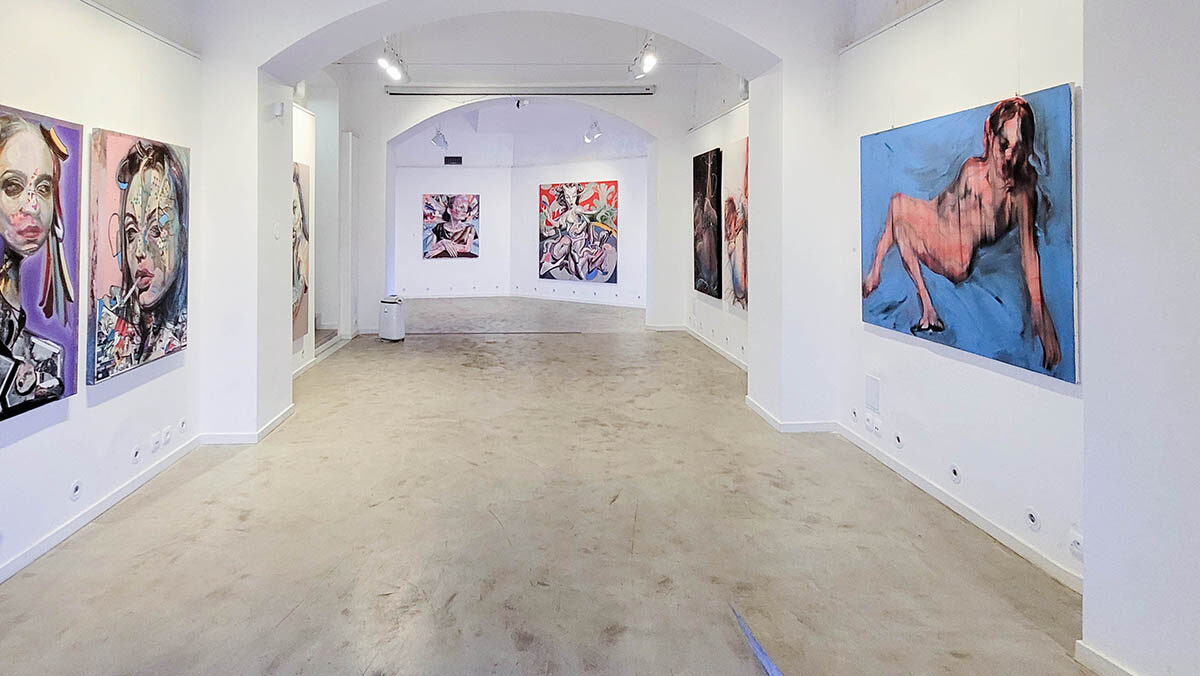
Du hast gerade eine Einzelausstellung in der Galerie Toyen mit dem Titel “PRINCESSES”. Wie bist du auf dieses ausschließlich feminine Thema gekommen?
Ich habe mich gefragt, welchen Teil meiner Arbeit ich zeigen möchte und zwei Faktoren haben mich auf das Thema Frauen gebracht. Es ist einerseits ganz natürlich, da ich in letzter Zeit mehr Frauenbildnisse male als früher. Andererseits der Name der Galerie selbst. Toyen war eine wichtige tschechische, surrealistische Malerin, der es gelungen ist, sich in der damaligen, von Männern dominierten Kunstszene als eine der wenigen weiblichen Künstlerinnen zu etablieren.
Wie wichtig ist im Allgemeinen die Wahl eines Titels für ein Werk oder eine Ausstellung für dich? Wie wählst du Titel und hast du jemals einen Titel im Nachhinein ausgewechselt?
Je älter (und weiser 😉 ) Ich werde, desto mehr wird mir klar, dass ein Titel große Bedeutung hat. Einen Titel zu finden ist die gleiche kreative Aktivität wie das Malen eines Bildes, es ist Poesie. Mit dem Titel möchte ich aufzeigen (vorzugsweise in poetischer Form) was sich hinter dem Erschaffen einer Arbeit abspielt und was mich dazu gebracht hat, den Betrachter in eine bestimmte Richtung lenken (fur Wahrnehmung/Akzeptanz/Verständnis des Bildes). Aber ich möchte ihm nicht die Möglichkeit nehmen, neue oder andere Verbindungen, Beobachtungen oder andere Formen des Verständnisses zu finden. Ein Titel, der buchstäblich und direkt beschreibt und bestimmt, wie man ein Bild lesen soll oder unter welchem Blickwinkel ist nicht ideal. Er sollte mysteriös sein statt direkt und beschreibend. Er sollte wie Gedanken in ein Gedicht eingeflochten sein. Manchmal, wenn ich ein Bild fertigstelle, ruft es etwas Bestimmtes in mir hervor, evoziert etwas (zum Beispiel etwas aus der Literatur, einem Film usw.) und das führt zu einem Titel… Aber das ist nicht immer der Fall. Ein Detail im Bild etwa. Oder alles, was irgendwie mit der Kreation des Bildes verbunden war. Was das Umbenennen älterer Werke angeht… das mache ich die ganze Zeit. Manchmal bekommt eine alte Arbeit mehrere neue Titel über die Jahre. Mit der Zeit nehme ich sie anders wahr und der ursprüngliche Titel verliert seine Bedeutung. Das Bild gibt uns neue Assoziationen, neue Realitäten und wir finden etwas Neues darin.
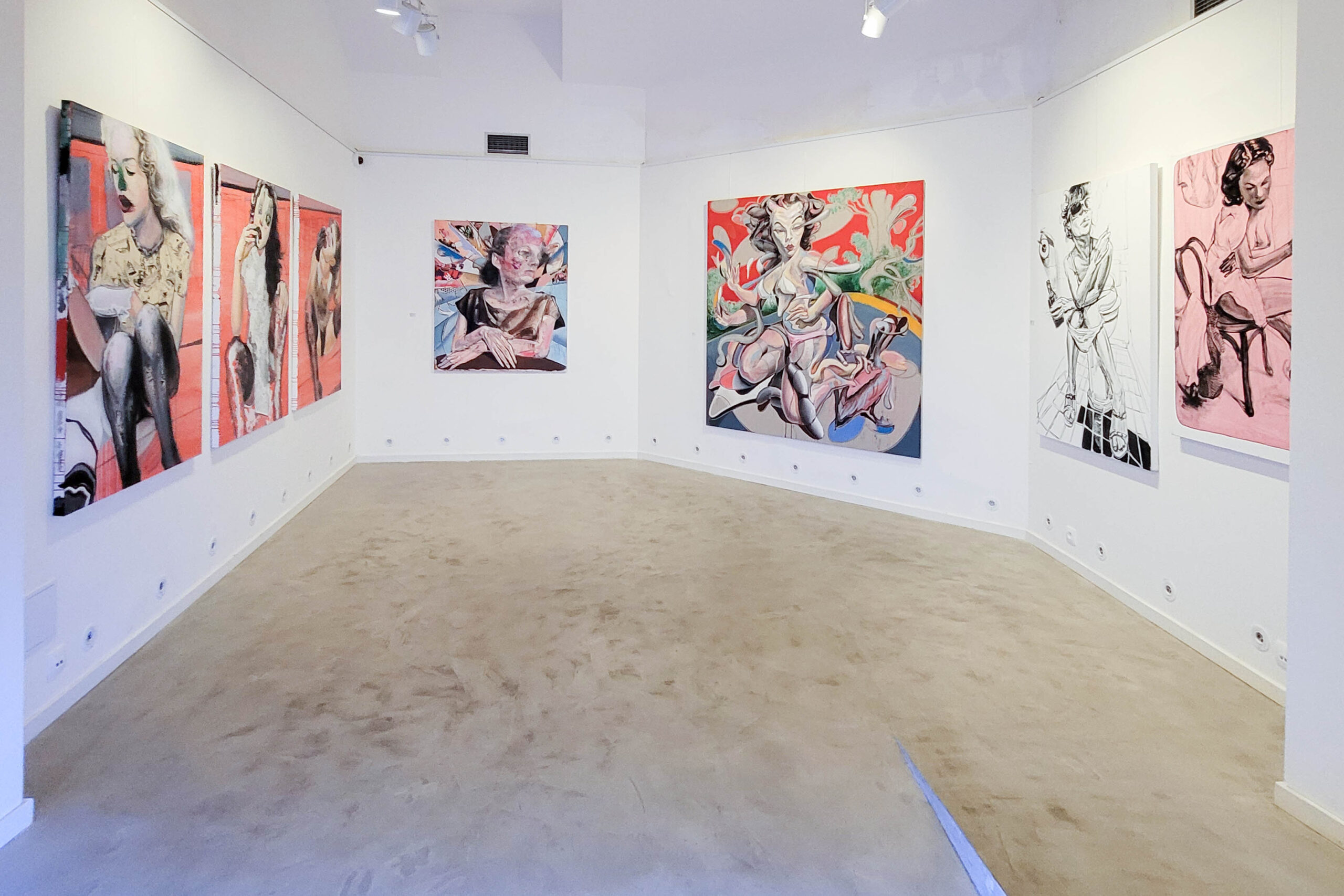
Aus den verschiedenen Arbeiten und Titeln in dieser Ausstellung geht ein sehr breites soziales Spektrum hervor. Von der Unterwelt bis zum Göttlichen. Was ist deine Definition von “Prinzessin”?
Ich verbinde Prinzessinnen mit meiner Kindheit. Mädchen wollten Prinzessinnen sein. In Märchen sehen wir Prinzessinen als Heldinnen, als Hauptcharaktere der Geschichte, die normalerweise ein gutes Ende finden. Das Gute triumphiert über das Bose usw. Es ist ein Archetyp (diese Geschichten oder das Prinzessinnen-Ideal). Nach dem Abenteuer bekommt die Prinzessin alles, was sie mochte. Wie gesagt, es ist ein Archetyp, das in mündlicher und schriftlicher Überlieferung über Jahrhunderte hinweg auftaucht. Es ist wie der zeitgenössische “American Dream”. Dabei fällt mir ein, dass man sagen könnte in der heutigen Welt seien Frauen aus dem show-business (Schauspielerinnen, Sängerinnen, Models…) ähnlich wie die Prinzessinnen in den Geschichten… einfach erfolgreiche Frauen aus allen möglichen Bereichen. Alle diese Ikonen erfüllen das Prinzessinnen-Ideal. Überall werden Prinzessinen wie diese durch die Frauen von heute definiert. Das ist der Grund, warum ich in manchen meiner Titel das Heilige (Göttliche) anspreche… Weiter zu den Namen: Wir finden hier Hinweise auf alte Meisterwerke, diese Dinge sind verbunden… Meine Bewunderung für die Maler, deren Werke ich zitiere, ist ähnlich zu dem, wovon ich vorher gesprochen habe (Ikonen, idealisierte Frauen). Jetzt fällt mir ein, dass wir, wenn wir Ideale erzeugen, irgendwie ein lebendes Wesen töten, wie machen uns ein verzerrtes Bild von jemandem, das eine bestimmte Person seiner Existenz beraubt und sie übersteigt. Leben wird ersetzt durch Virtualität, Fiktion… Außerdem enthalten die Titel Hinweise auf Lieder und Filme, die uns an das Leben von Prinzessinnen erinnern (wie wir es uns im kollektiven Unbewussten vorstellen). Dolce vita, California dreaming… Selbstverständlich können Prinzessinnen auch bose sein… aber das weicht von dem Bild ab, dass sich die Gesellschaft von Prinzessinnen gemacht hat und weithin als richtig und legitim angesehen wird. Von der Essenz des Archetyps an sehen wir sie nur als Gipfel von Kultur, Schönheit usw., mit einem Hauch von Privilegiertheit. Prinzessinnen sind in unbewussten psychischen Prozessen, künstlich erzeugte Wesen. Und das geht schon Jahrhunderte so. Sie sind teil des kollektiven Unterbewusstseins. Geschichten, die über Jahrhunderte Kraft und Bedeutung gewonnen haben, und wir opfern uns selbst auf dem Altar dieser Konfiguration menschlicher Existenz.
“Alte Meister”, Popkultur, Traume, Filme und Serien, Geschichte, Zeitschriften, Literatur, Fotografie… kannst du uns sagen, wo diese “Prinzessinnen” herkommen, aus welcher Art von “Reich”?
Aus welchem Reich… wie ich schon vorher angedeutet habe, aus der Welt heutiger Geschichten, der Welt der Medien. In Wirklichkeit sind die sozialen Netzwerke voll damit, sie erlauben jedem seine Träume zu erfüllen, Prinzessinnen zu sein. Frauen, aber auch Männer, zeigen ihr “Prinzessinnengesicht” (in dem Sinne des allgemein akzeptierten Ideals von dem ich vorhin gesprochen habe).
Du hast diesen Sommer in zahlreichen Ausstellungen in CZ teilgenommen, in denen Frauen rauchend oder als “femme fatale” dargestellt sind. Wie wichtig ist diese Ästhetik in deiner Arbeit?
Die « femme fatale » ist ein anderer faszinierender Archetypus aus der Welt der Kunst und Literatur… ich verbinde ihn mit Superhelden und Comics… mit übernatürlichen Fähigkeiten, aber nicht immer mit guten Absichten. Mich haben immer schon Charaktere aus der Unterwelt und Superhelden begeistert. Ich denke die femme fatale hat etwas von beiden Seiten. Diese Dualität ist interessant für mich. Damit kann ich auch gleich deine nächste Frage beantworten.
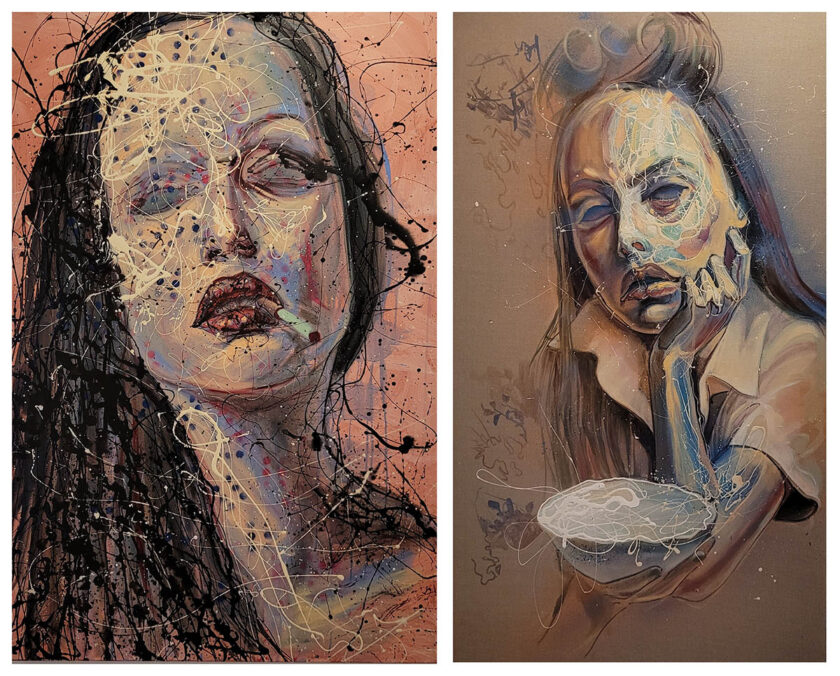
Was kommt als Nächstes? Wie geht die Vorbereitung der nächsten Saison voran und hast du schon ein Thema für deine nächsten Ausstellungen?
Ich denke gerade über diese Beziehung zwischen zwei unvereinbaren Eigenschaften nach, die in einem Paket auftreten. Das berühmteste Beispiel ist sicher Dr. Jekyll and Mr. Hyde. Ein weiterer Archetypus. Hulk and Dr. Baner sind zum Beispiel in den Comics vertreten. Ich glaube in der figurativen Malerei geht es hauptsächlich um Psychologie und daher ist dieses Thema der Persönlichkeitsspaltung (oder Schizophrenie, oder mehrerer Persönlichkeiten) sehr faszinierend für mich, voll von Möglichkeiten wie man es visuell erfassen und verarbeiten kann. Ein anderes Beispiel ist der Gott Janus. Auch hier sehe ich wieder einen jahrhundertealten Archetypus. Ich sähe gerne, dass etwas von meinen Gedanken zu diesem Dualismus in meiner nächsten Ausstellung “Magic Monsters” erscheint. Der Titel soll meinen Ansatz und meine Einstellung zu diesem Thema verdeutlichen… Magie tragt in sich etwas, das uns begeistert, und selbst wenn dieses Wort das Problem von was real und irreal ist mit sich bringt, ist es für mich der helle Teil des Titels. Aber im Hintergrund der Ausstellung werden wir auch die dunklen Möglichkeiten sehen… denn Monster, auf dern anderen Seite, haben negative Konnotationen. Ganz Allgemein. Aber wenn wir etwas genauer nachdenken, sehen wir, dass Monster großartige Dinge in die Welt bringen können, durch monströse Taten. Man könnte sagen, ein genialer Akt ist eine monströse Angelegenheit und Genie mit Monstern gleichsetzen.
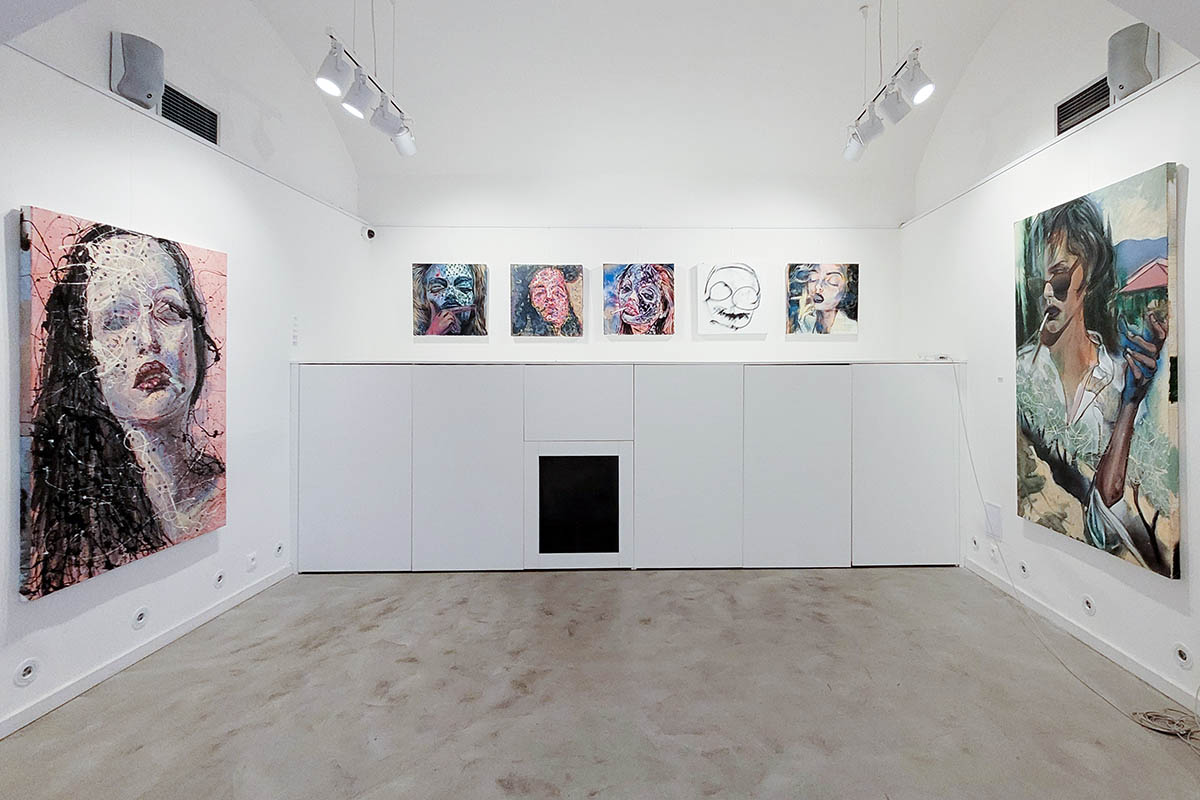
Eine deiner Arbeiten sticht besonders durch Abstraktion und fast völlige Abwesenheit von Farbe hervor: “Geist des Alkohol”. In einer Ausstellung unter dem Namen “Prinzessinnen”, kannst du uns erklären wie und warum dieser Geist weiblich ist?
Man kann sagen, dass Mädchen teilweise für meine früheren Probleme mit Alkohol verantwortlich waren. Als ich junger war, war ich sehr schüchtern, anders gesagt war es sehr schwer für mich mit Leuten zu sprechen, zu kommunizieren; besonders mit Mädchen meines Alters und vor allem mit denen, die ich gern hatte. Ich habe begonnen, dieses Handicap mit Alkohol zu beseitigen. Nur zu empfehlen, die Hilfe war unbezahlbar… Deswegen schwebt der Geist über Frauen wie ein alter Freund, wie eine verschwommene Erinnerung an verlorene Jugend, ein Geist aus der Vergangenheit, der zuerst Freund und dann Alptraum war.
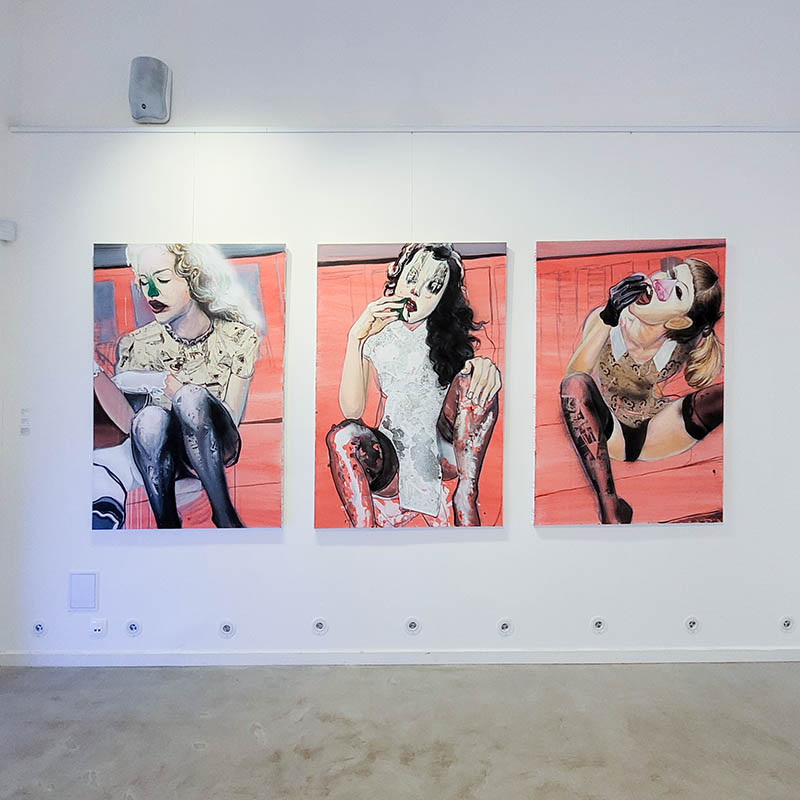
In dieser Ausstellung gibt es mehrere kleinere, quadratische Formate (60 x 60 cm). Wie beeinflusst das seine Kompositionen und arbeitest du gerne mit diesem Format?
Ich verwende dieses Format nicht oft, aber es stellt kein Problem für mich dar. In der Hauptsache ist es ein Format, das manche Entscheidungen sehr einfach macht. In einem rechteckigen Format musst du über die Komposition nachdenken (zum Beispiel wenn du Material von Fotografien auf die Leinwand bringen möchtest), da ist manchmal die horizontale oder vertikale Ausrichtung besser (das kommt auf die Anzahl von Figuren an…) usw. Im Gegensatz dazu, in einem quadratischen Format, finden Figuren ihren Platz ganz natürlich und die Komposition ist gleich, unabhängig von der Ausrichtung, die du am Anfang wählst. Es ist ein kleines Abenteuer! Diese Leinwände hatten außerdem die interessante Eigenschaft, 6cm dick zu sein. Das verstärkt ihre physische Präsenz.
Du hast “Art is easy” auf deinem Malarm tätowiert. Was bedeutet das und wie beeinflusst das dein Malen und Denken?
Dieser Satz scheint öfter in den Texten mancher Künstler auf… Aber das Tattoo war ein alkoholbedingter Fehler, euphorisch und unvernünftig. Es ist eine Erinnerung an schlechte Zeiten in der Vergangenheit, als ich betrunken gemalt habe, um Euphorie und Leichtigkeit zu fühlen, frei von Angst. Jetzt, da ich nicht mehr trinke, ist es da, um mich dazu zu bringen, furchtlos und enthusiastisch zu handeln. Wir tschechischen Künstler verwenden den Ausdruck “Utahanỳ”, erschöpft, um zu Beschreiben, dass sich eine Arbeit in eine falsche Richtung geht. Schritt für Schritt wird es schlechter, du merkst es nicht gleich, manchmal glaubst du, es wird sogar besser. Manchmal machen Leute fehler und merken es nicht gleich. Die grösste Schwierigkeit liegt darin zu wissen, wann man aufhören soll, sie bringen dir das auch auf der Kunstschule bei “du musst wissen, wenn du fertig bist”. Das ist jedesmal aufs neue eine Herausforderung.
Tomáš Jetela – www.tomasjetela.com, www.instagram.com/tomasjetela/



